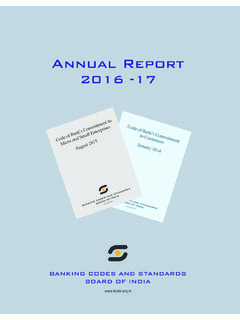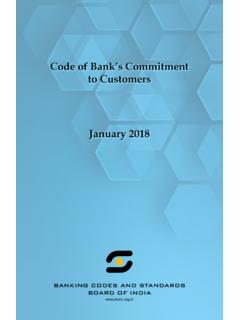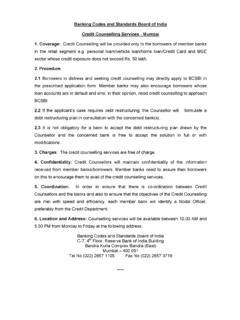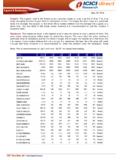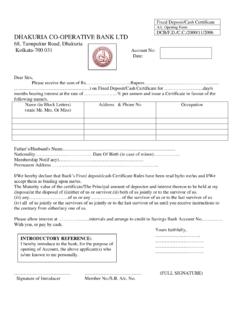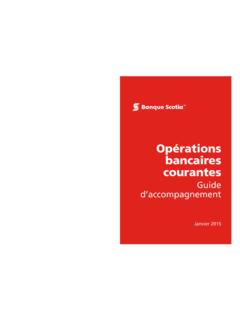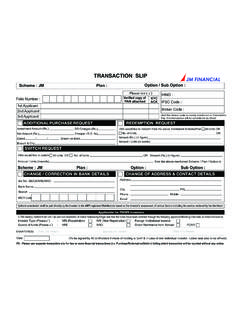Transcription of BANKING CODES AND STANDARDS BOARD OF …
1 BANKING CODES AND STANDARDS BOARD OF INDIA. BCSBI code Compliance Rating 2017. Background: As a part of its mandate, BCSBI has been monitoring compliance with the CODES of Bank's Commitment to Customers' and Bank's Commitment to Micro & Small Enterprises' by carrying out visits to select branches of member banks for verifying implementation of the CODES by them. For this purpose, BCSBI's authorized representatives collect information through a structured questionnaire on implementation of the important code provisions by visiting a representative sample of such branches. During such visits, BCSBI representatives also interact with a few customers of the bank branches and obtain their feedback. From the year 2013, BCSBI started rating of banks for which the input from branch visits and customer feedback is being used.
2 The rating may be considered as an indicator of the level of implementation of important code provisions at grass root level of a bank and the same is denoted as BCSBI code Compliance Rating'. Methodology: For the purpose of rating of the banks, BCSBI has developed a rating model with the help of the rating agency CRISIL. Accordingly, the Branch Visit findings and Customer feedback are grouped into five main categories and allocated them numerical weightages. These groups and weightages assigned to them, for current exercise, are as under: Sr. No Group of prameters Weightage 1 Information dissemination 20. 2 Transparency 22. 3 Customer centricity 30. 4 Grievance redressal 15. 5 Customer feedback 13. Total 100. BCSBI assigns the rating to banks based on the overall score achieved by them out of 100 as per the scale below: Scoring Scale - Out of 100 Rating category 85 and above High 70 to less than 85 Above Average 60 to less than 70 Average Below 60 Below Average Based on the above methodology, BCSBI has recently concluded code Compliance rating exercise.
3 The rating category achieved by each of the banks covered in the said exercise along with the overall score and scores under abovementioned parameter groups for current exercise are shown in the Annexure along with the rating of the previous exercise. An analysis of overall rating and also segment-wise performance, together with comparison of the previous round of rating exercise is given below: Analysis of code Compliance Rating -2017. vis- -vis Previous (2015) rating exercise Overall Rating One of the salient features of the current survey is inclusion of five select Scheduled Urban Cooperative Banks for the first time and all of them have achieved rating under Above Average' category. Considering this aspect, it can be seen from the following tables that there has not been much of a change in terms of number of banks under each of the rating categories: Rating Number of Banks 2017 2015.
4 1 High 12 13. 2 Above Average 29 23. 3 Average 10 10. 4 Below Average 0 0. Total number of banks 51 46. surveyed The following table shows the Comparison of code Compliance Performance of different BANKING Groups: Number of banks Rating category High Above average Average Total Year 2017 2015 2017 2015 2017 2015 2017 2015. Bank Group Public Sector Banks 1 1 15 15 10 10 26 26. (PSBs). Private Banks 8 9 9 8 0 0 17 17. Foreign Banks 3 3 0 0 0 0 3 3. Total 12 13 24 23 10 10 46 46. Scheduled Urban Coop Banks 0 NA 5 NA 0 NA 5 NA. (SUCBs). (Newly added). Total 12 13 29 23 10 10 51 46. 2. Though, there has not been much of a change in terms of number of banks in each of the categories of rating, except addition of the SUCBs under Above average . category, there have been upgradations and slippages in the rating categories of some of the banks.
5 DCB Bank Ltd has upgraded from Above average to High . category, while Tamilnad Mercantile Bank Ltd and Dhanlaxmi Bank Ltd have slipped into Above average from High category. Similarly, four PSBs viz. Central Bank of India, Corporation Bank, UCO Bank and Union Bank of India have moved up into Above average from their Average rating category in the previous exercise. There has been slippage of equal number of banks viz. Andhra Bank, Bank of Maharashtra and State Bank of Patiala, State Bank of Bikaner and Jaipur (since merged with State Bank of India) into Average rating category from Above average . a) Overall Score by different BANKING groups The overall average score achieved by different BANKING groups during 2015 and 2017 is shown in the following table and the corresponding chart: Year 2015 2017.
6 PSBs 72 70. Private 85 83. Bank Group Foreign 93 92. SUCBs NA 77. All 78 77. banks There is a marginal decrease in the overall average score of banks during 2017. This may be attributed to i) rephrasing of the parameters with emphasis on customer centricity of banks and also qualitative aspects of compliance ii) increased prominence given to complaints received by BANKING Ombudsman (under the category of grievance redressal) and iii) more weightage for customer feedback as compared to the previous exercise ( from 10% to 13%). The overall performance of foreign banks continued to be better than that of other groups. 3. b) Information dissemination: The average score achieved by different BANKING groups under parameters group Information dissemination' is shown in the following table and the corresponding chart: Year 2015 2017.
7 PSBs 64 62. Private 88 86. Bank Group Foreign 97 97. SUCBs NA 75. All 75 73. banks Overall there is a marginal decline in compliance under Information dissemination'. even though the foreign banks as a group have retained their top position at a much higher level of 97%. Among the other BANKING groups, Public Sector Banks need to substantially improve their compliance on parameters grouped under Information dissemination', as their overall score as a group is the lowest one. c) Transparency: The average score achieved by different BANKING group under parameters group Transparency' is shown in the following table and the corresponding chart: Year 2015 2017. PSBs 70 63. Private 83 80. Bank Group Foreign 97 99. SUCBs NA 71. All 77 71. banks 4. There is a sharp decline in the overall score under the parameter group Transparency' mainly owing to a drastic fall in the score of Public Sector Banks.
8 Although, there is a significant decline in compliance under Transparency', the foreign banks have improved their compliance level almost close to perfect. As the overall score of PSBs as a group is much lower as compared with other groups, they need to improve their compliance under this parameters group too. d) Customer centricity: The average score achieved by different BANKING groups under parameters group Customer centricity' is shown in the following table and the corresponding chart: Year 2015 2017. PSBs 73 72. Private 84 82. Bank Group Foreign 89 93. SUCBs NA 70. All 78 77. banks Although there a is marginal decline in overall compliance under Customer centricity', the foreign banks have further improved their position at a higher level of 93%. The average score of Scheduled Urban Cooperative Sector Banks and PSBs as groups is much lower in comparison with the score of private and foreign banks.
9 5. e) Grievance redressal The average score achieved by different BANKING group under parameters group Grievance redressal' is shown in the following table and the corresponding chart: Year 2015 2017. PSBs 77 80. Private 84 86. Bank Group Foreign 88 79. SUCBs NA 94. All 80 83. banks This is the only group of parameters among the five in which there is improvement in average score of all banks put together. This is also the only group of parameters in which score of foreign banks has declined and their average score in this category is lowest amongst the five BANKING groups. The group of scheduled urban cooperative banks has performed well and their average score in this category is highest amongst the five parameter groups. It is noteworthy that this time more weightage was given for the complaints lodged with BANKING ombudsmen offices, their maintainability and complaints owing to non-compliance with BCSBI CODES .
10 F) Customer feedback: Year 2015 2017. PSBs 86 82. Private 90 84. Bank Group Foreign 89 90. SUCBs NA 88. All 88 84. banks 6. This parameter is judged by seeking answers to queries from customers. Although there is a decline in the score achieved by all banks put together on the basis of customer feedback, there is a marginal increase in the score of foreign banks. Customers in general look forward to improvement in the following areas: i) Clarity in the information displayed on Notice BOARD of the branches ii) Communication relating to change of interest rates and service charges and iii) Working of ATMs Limitation of the Survey: The rating is a limited exercise intended only for gauging the level of adherence to the two CODES , Bank's Commitment to Customers and Micro and Small Enterprises and is based on a sample size of 2 to of the branch network of 51.
